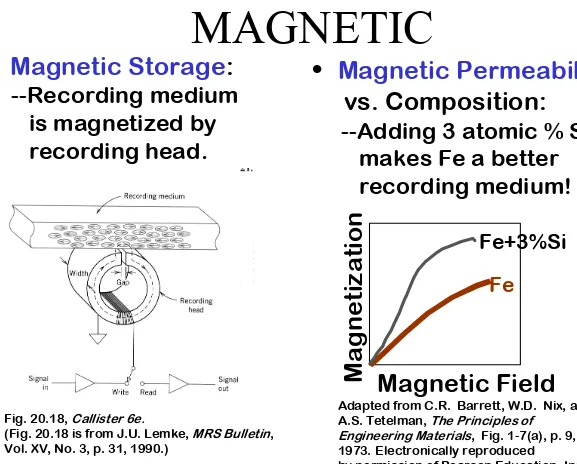Chapter 1 Materials for Engineering
Materials Science and
Engineering
• Materials Science – Investigating
relationships that exist between the structure
and properties of materials
• Materials Engineering – Is, on the basis of
these structure-property correlations,
Structure
• Sub atomic – electrons and nuclei (protons
and neutrons)
• Atomic – organization of atoms or
molecules
• Microscopic – groups of atoms that are
normally agglomerated together
Terminology
mil = 1 / 1000 inch = 25.4 µm
micrometer = 1 / 1,000,000 meter = 1µm
Angstrom = 1 / 10,000,000,000 meter = 1Å
1 MICROMETER IS TWO WAVELENGTHS OF GREEN LIGHT LONG
A 1 MICRON WIDE LINE ON A CD
IS THE SAME SCALE AS A 100 FOOT
Progress in atomic-l
ev
el understanding
DNA
Things Natural Things Manmade
10 nm
ATP synthase
Schematic, central core
Cat
MEMS (MicroElectroMechanical Systems) Devices
10 -100 µm wide
Red blood cells Pollen grain
Fly ash
~ 10-20 µm
Bee
~ 15 mm
Atoms of silicon
spacing ~tenths of nm
Head of a pin
1-2 mm
Magnetic domains garnet
film quantum dot
Quantum dot array --germanium dots on silicon Microelectronics
Objects fashioned from metals, ceramics, glasses, polymers ...
Human hair
1 nanometer (nm)
0.01 µm
1 millimeter (mm)
0.01 m
e with desir
ed pr
operties and functionality
Red blood cells with white cell
Processing
Structure
Properties
ex: hardness vs structure of steel
•
Properties
depend on
structure
Data obtained from Figs. 10.21(a) and 10.23 with 4wt%C composition, and from Fig. 11.13 and associated discussion, Callister 6e.
Micrographs adapted from (a) Fig. 10.10; (b) Fig. 9.27;(c) Fig. 10.24; and (d) Fig. 10.12, Callister 6e.
ex: structure vs cooling rate of steel
•
Processing
can change
structure
Structure, Processing, & Properties
1.
Pick
Application
Determine required
Properties
2.
Properties
Identify candidate
Material(s)
3.
Material
Identify required
Processing
Processing: changes
structure
and overall
shape
ex: casting, sintering, vapor deposition, doping
forming, joining, annealing.
Properties: mechanical, electrical, thermal,
magnetic, optical, deteriorative.
Material: structure, composition.
Composition, Bonding, Crystal Structure
and Microstructure DEFINE Materials Properties
Composition
Bonding
Crystal Structure
Thermomechanical
Processing
Microstructure
Mechanical
Properties
T (°C)
• Electrical Resistivity of Copper:
Adapted from Fig. 18.8, Callister 6e. (Fig. 18.8 adapted from: J.O. Linde,
Ann Physik5, 219 (1932); and
C.A. Wert and R.M. Thomson, Physics of Solids, 2nd edition, McGraw-Hill Company, New York, 1970.)
•
Magnetic Permeability
vs. Composition:
--Adding 3 atomic % Si
makes Fe a better
recording medium!
Magnetic Field
Magnetization
Fe+3%Si
Fe
Adapted from C.R. Barrett, W.D. Nix, and A.S. Tetelman, The Principles of
Engineering Materials, Fig. 1-7(a), p. 9, 1973. Electronically reproduced
by permission of Pearson Education, Inc., Upper Saddle River, New Jersey.
Fig. 20.18, Callister 6e.
(Fig. 20.18 is from J.U. Lemke, MRS Bulletin, Vol. XV, No. 3, p. 31, 1990.)
•
Magnetic Storage
:
--Recording medium
is magnetized by
recording head.
•
Transmittance
:
--Aluminum oxide may be transparent, translucent, or
opaque depending on the material structure.
Adapted from Fig. 1.2, Callister 6e.
(Specimen preparation,
single crystal
polycrystal:
low porosity
polycrystal:
high porosity
• Stress & Saltwater...
--causes cracks!
• Heat treatment:
slows
crack speed in salt water!
4µm
--material:
7150-T651 Al "alloy"
(Zn,Cu,Mg,Zr)
Adapted from Fig. 11.20(b), R.W. Hertzberg, "Deformation and Fracture Mechanics of Engineering Materials" (4th ed.), p. 505, John Wiley and Sons, 1996. (Original source: Markus O.
Speidel, Brown Boveri Co.) Adapted from Fig. 17.0, Callister 6e.
(Fig. 17.0 is from Marine Corrosion, Causes, and Prevention, John Wiley and Sons, Inc., 1975.)
Adapted from Fig. 11.24,
Callister 6e. (Fig. 11.24 provided courtesy of G.H. Narayanan and A.G. Miller, Boeing Commercial
“held at
160C for 1hr
before testing”
increasing load
crack speed (m/s)
“as-is”
10 -10
10 -8
Alloy 7178 tested in saturated aqueous NaCl solution at 23C
